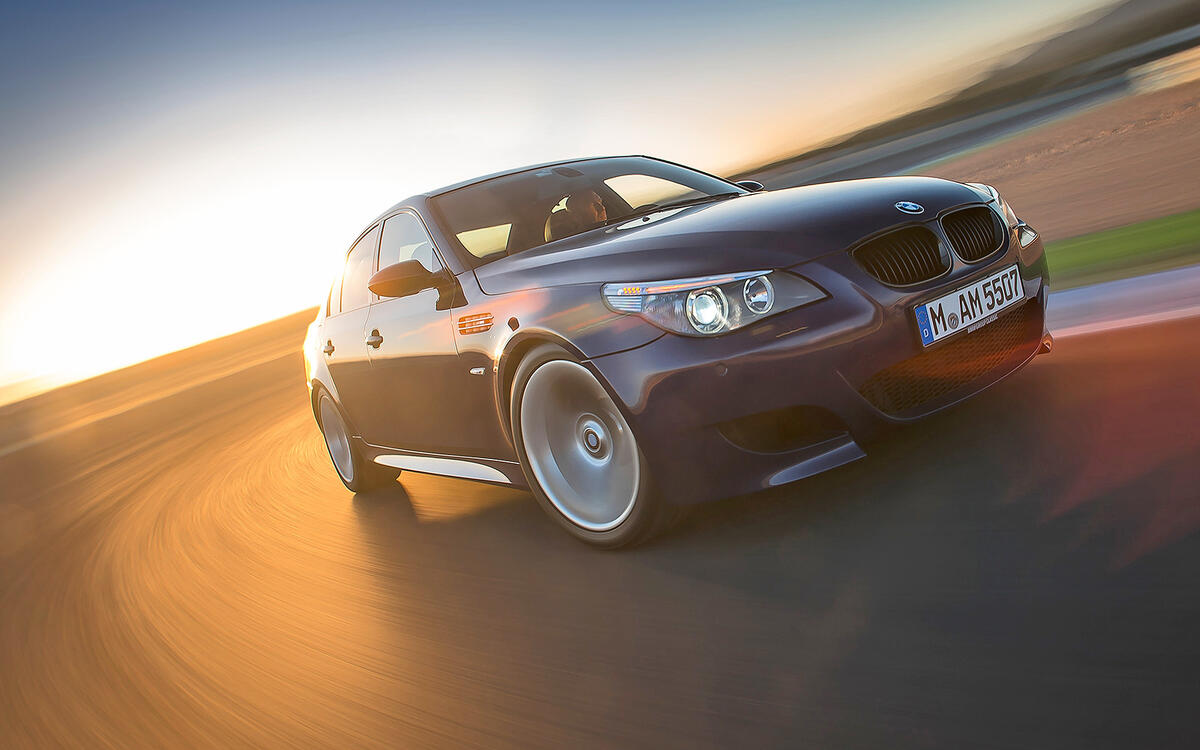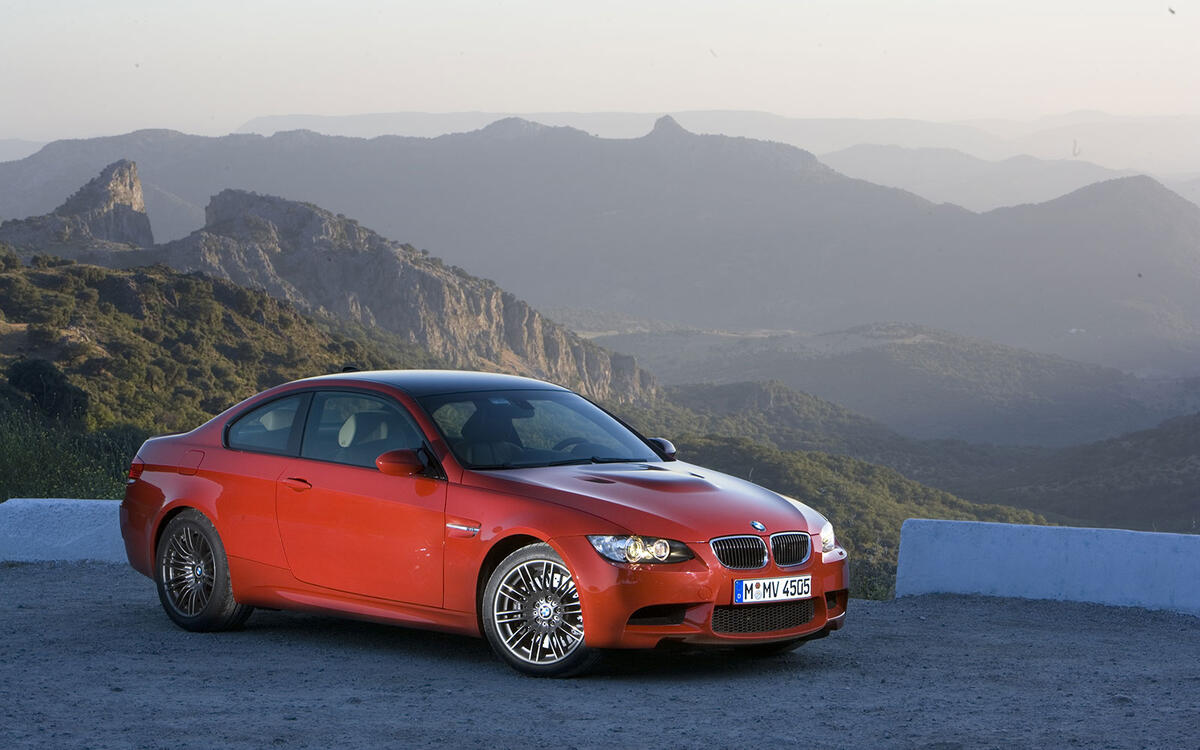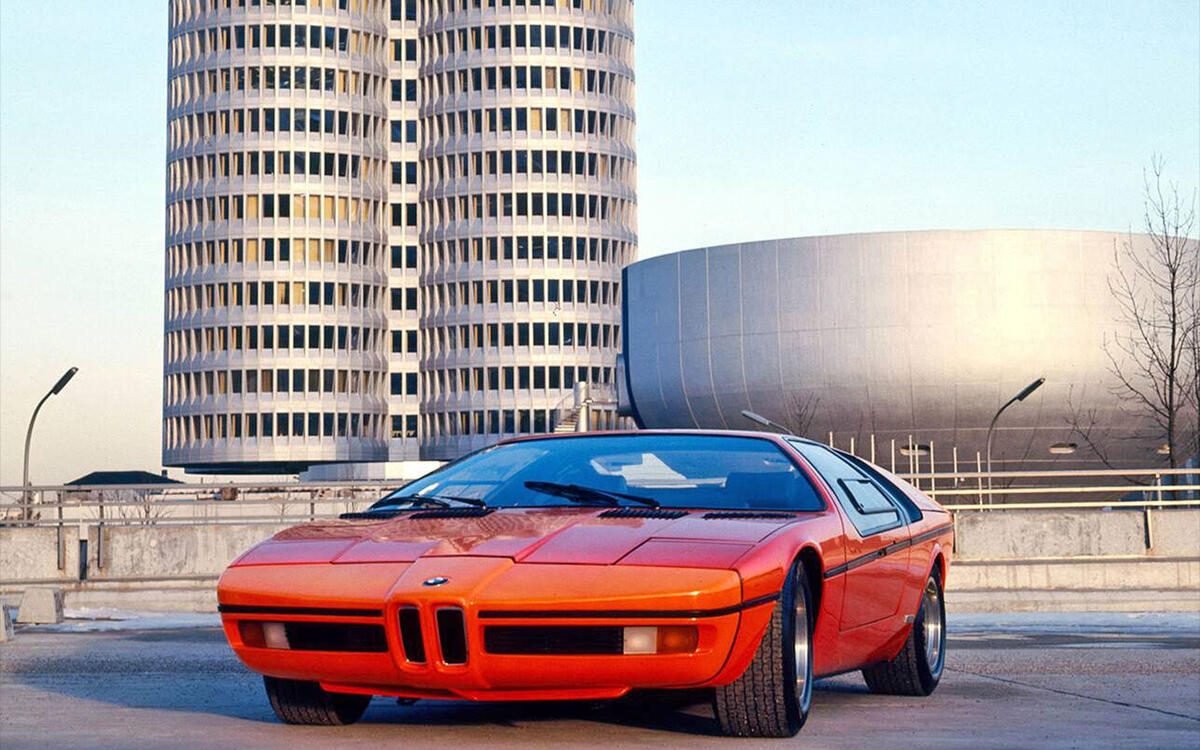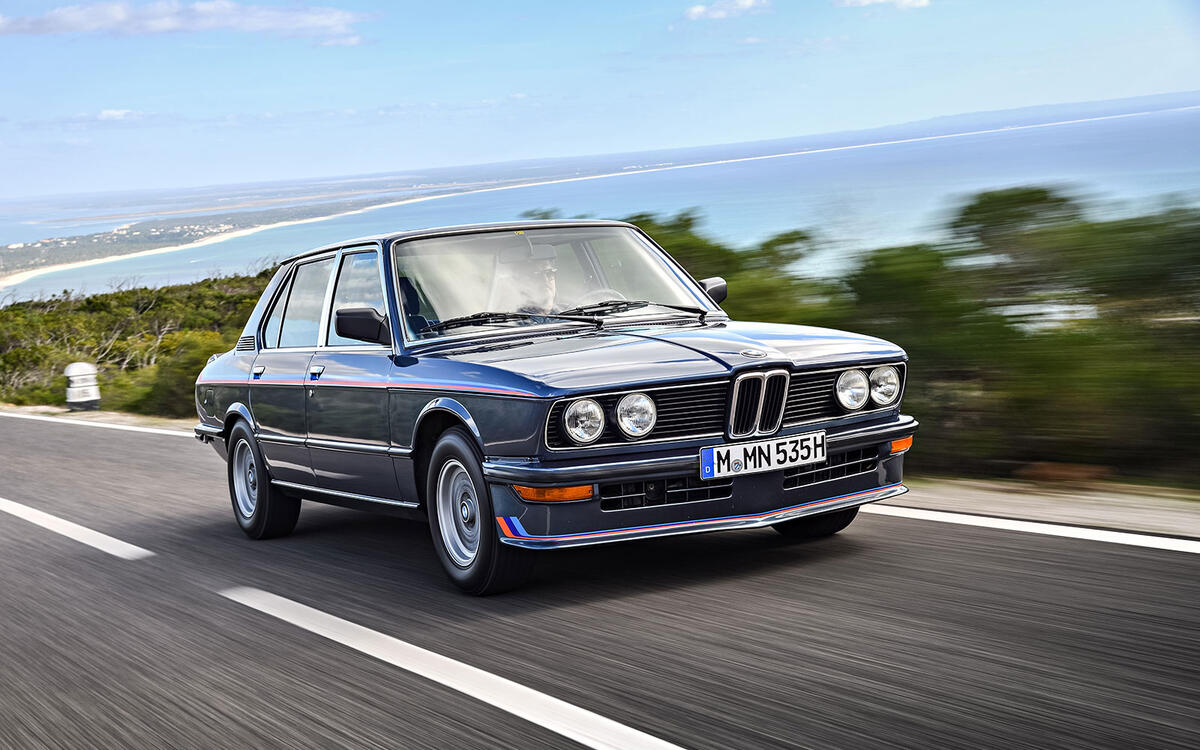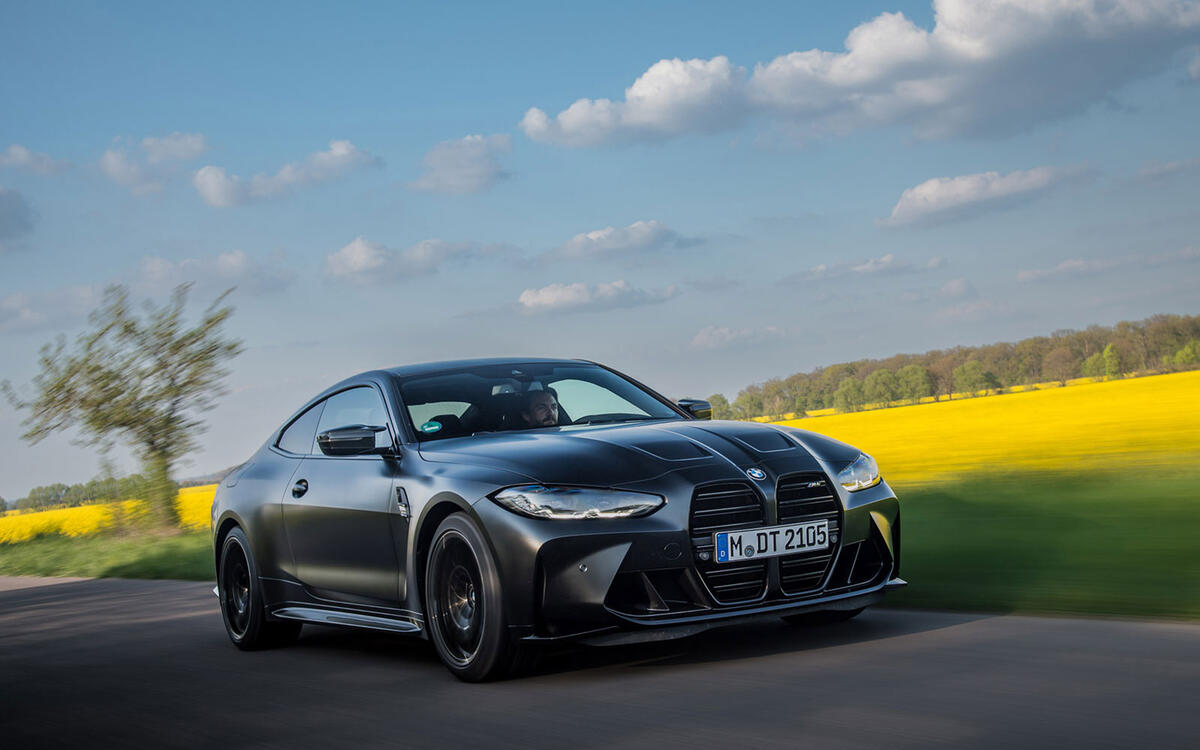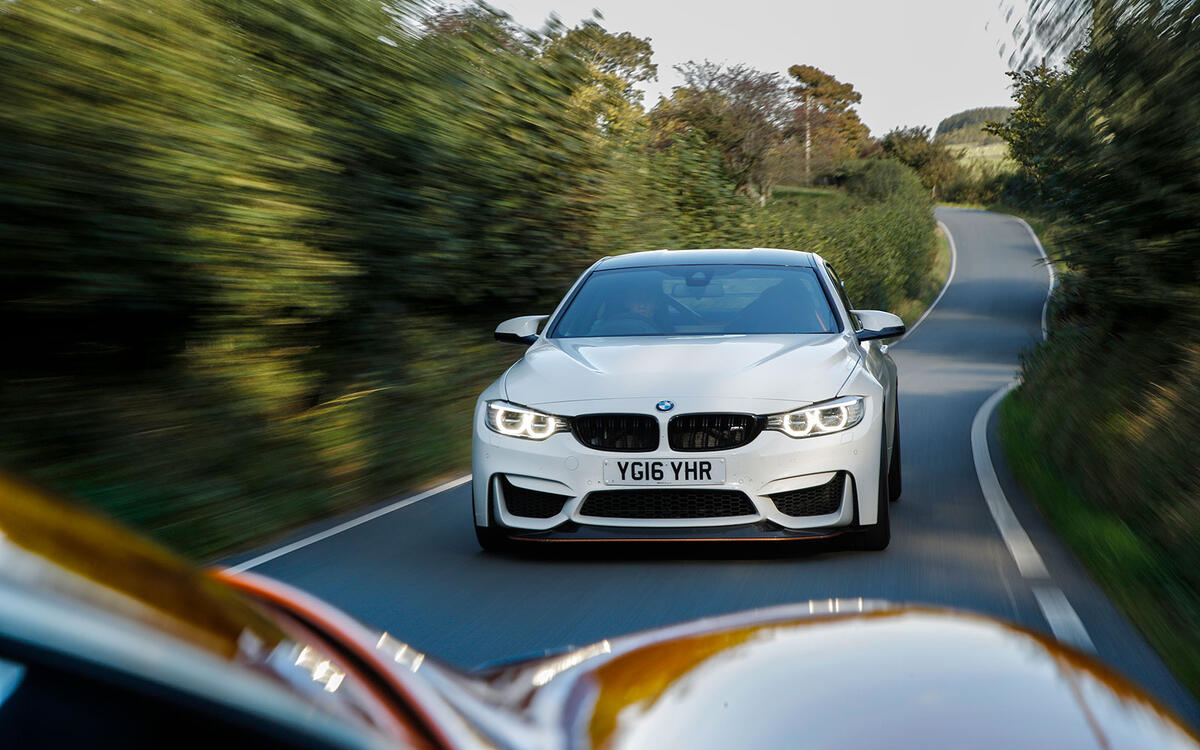 Slide of
Slide of
BMW’s M division celebrated its 50th anniversary this summer.
And it’s certainly produced some mighty and exciting cars over that period. In this feature the Autocar team chooses its best – and outlines some of their best M-powered adventures…
 Slide of
Slide of
E34 M5
While values of its E28 forebear have shot up and its E39 successor is lauded as one of the best M5s, the E34 is largely overlooked, yet to me it’s one of the most magnificent M cars ever. With its crisp lines subtly enhanced by a small front spoiler and turbine wheels, its elegance hides real muscle in the form of a howling 315bhp 3.5-litre straight six. Later cars are faster still, thanks to a 340bhp 3.8-litre engine and six-speed manual gearbox. The steering is slow by today’s standards and the chassis is a little soft, but it’s beautifully balanced, and it’s tiny, so never feels unwieldy.
 Slide of
Slide of
E34 M5
It was built tough, but you will still need to find one with a history so clean that you would eat your dinner off it, while rust is a very real problem. It’s getting rare, too, but keep looking and you should find that £20,000 (one-fifth of what you need for an E30 M3) buys you a tidy E34 M5 that will be just as happy as a daily hack as it will be as an entertainer. JAMES DISDALE
 Slide of
Slide of
E46 M3
There are so many candidates here, but we can dismiss the SUVs, purists will focus only on the coupés and saloons and all bar the abnormally brave will steer well clear of anything with a V10 under its bonnet.
The best rule of thumb with M cars is that less really is more, and it always has been. Such cars are cheaper, lighter and better to drive than their high-powered overweight brethren. All second-hand cars are heinously expensive right now, but a five-year-old M2 for £27,000 looks tempting and less than £20,000 is probably enough to secure an E90-generation M3, complete with its screaming naturally aspirated V8 and, crucially, the standard manual gearbox.
 Slide of
Slide of
E46 M3
But if there is one outstanding used M car, it has to be an E46 M3, built between 2000 and 2006. Powered by a searing straight six and with astonishing chassis balance, in terms of value for money and driving pleasure delivered, this is the greatest M car in the world today.
You can pick up leggy cars for as little as £16,000, but it might be cheaper in the long run to set aside £25,000 and get a late-model, low mileage coupé. And avoid the SMG gearbox… ANDREW FRANKEL
 Slide of
Slide of
E90 M3
While many have lost money trying to second-guess the market for used M cars, it’s clear that the 2007 M3 is a l ready on an upward trajectory, one driven by the fact that it is, with the exception of the ultra rare E46 M3 GTR, the only V8-powered M3.
The engine is a technical marvel, closely related to the 5.0-l it re V10 in the E60 M5 and with the same linear responses and love for revs. Peak power comes at a heady 8300rpm. It has some of the same weaknesses, too, including a tendency for hard-used examples to spin their rod bearings, but there’s a good infrastructure of specialists and many owners have opted for proactive, rather than reactive, replacement.
 Slide of
Slide of
E90 M3
But while the E60 M5 has to work with a recalcitrant and jerky automated manual gearbox, the M3 got the option of a much smoother, much smarter dual-clutcher. This suits the car well, and most buyers in period opted for it, but the rarity of the six-speed manual now means it carries a premium.
The rest of the driving experience has aged similarly well, although running costs will always be high: matching the official 23mpg economy figure from a tank can be regarded as a very good score.
There are plenty of cars to choose from, albeit more early examples than later ones. The majority are E92 coupés, followed by E93 coupé-cabriolets (worth considering if you can live with the heavy folding hard top, as these are cheaper), while E90 saloons are both the rarest and priciest but also, to my mind, the best looking. Think of it as a baby M5 with a decent gearbox. MIKE DUFF
 Slide of
Slide of
E9 3.0 CSL
Everybody knows the 1973 Batmobile, but fewer know the carburetted 3.0 CSL that preceded it. For me, these earlier, rarer CSLs are perhaps the purest expression of BMW road racer, and better still, they’re more elegant than the Bats, which along with fuel-injection added the chunky wings and draping bumpers for an almighty but also comical level of presence.
The carb CSL was tidier and such a focused exercise in light-weighting. The doors, boot and bonnet were all made from aluminium, while the steel for the wings and roof was thinner than that used on the donor CS. There was no front bumper, the rear side windows were made from acrylic and the rest were made from thinner laminate. Insulation was mostly binned, as were boot and bonnet locks in favour of latches.
 Slide of
Slide of
E9 3.0 CSL
More fundamentally, the CSL ditched power steering and minimalist Scheel buckets were fitted to hold you in place while the M30 straight six and limited slip differential got to work. About 180kg was saved (roughly double that achieved by the new M4 CSL). Only 169 were made and none officially sold in the UK, as the car somewhat undermined the luxurious front that BMW’s UK concessionaires preferred to present. RICHARD LANE
 Slide of
Slide of
It’s easiest, I think, to pick my hands-down ultimate BMW and affix an M badge to the rear to arrive at my dream M car. And so it could only be the E39-generation M5. Because how on earth could taking one of the best-built, most handsome and perfectly balanced saloons of all time and endowing it with 394bhp’s worth of free-breathing V8 power be a recipe for anything but greatness?
Matt Saunders, the ecstatic helmsman of the car in this photo, said it best in remarking that it’s “unlike its modern antecedents in its simplicity, versatility, mechanical authenticity and deep-rooted analogue charm; and yet not unlike them at all in its ability to pin those neat l it t le door mirrors back and then hurl itself into the middle distance at a rate that makes it feel more than contemporary enough”.
 Slide of
Slide of
E39 M5
But it’s the subtlety and professionalism with which the E39 M5 conceals that firepower and deep-seated driver appeal that makes it such a product of its time (which, probably not coincidentally, was just as I was learning my crankshafts from my calipers) and lends it such unrivalled cult status in a modern context.
Fast BMWs have lost some of that understated approachability in recent years (albeit while making substantial gains in nearly every other respect), which is only making the relatively staid older models look like the more sophisticated choices. FELIX PAGE
 Slide of
Slide of
E25 Turbo Concept
Is this an M car or is this cheating? Yes, the first BMW road car with a ‘proper’ M badge was 1978’s M1 and M division wasn’t founded until 1972, the year that this concept car, the Turbo, was released. But look at this and then the M1 and you can see where it all started. Right here. So I’ll say this is my favourite M car.
The M1 was on the front cover of a BMW book by Stuart Bladon (a former Autocar staffer) that I bought as a kid, but it was the Turbo pictured inside that made my knobbly knees go weak. Its graduated paint couldn’t have been more ’ 70s and its chromed rims, gullwing doors and wheel half-covers were more Panthermobile than car.
 Slide of
Slide of
E25 Turbo Concept
Yes, it had a turbo four rather than the straight six the M1 got, it didn’t spawn a race series and, given that there were only two and both were show cars – built to celebrate the 1972 Munich Olympic games (which ended up being memorable for all the wrong reasons), it probably wasn’t built to handle, either. But still, when I was 10, I wanted one, and it’s still my dream BMW now, M or not. MATT PRIOR
 Slide of
Slide of
E36/8 Z3 M Coupe
The Z3 M Coupé isn’t a great-looking thing, and nor was it raved about as being one of the greatest-handling M cars when it arrived in 1998. But while teenaged me couldn’t imagine himself ever owning an E39 M5 or even an E46 M3, there seemed something arbitrarily attainable about the little E36/8.
Its clandestine skunkworks conception probably made it even more appealing. One look at this car tells you that it was the work of engineers messing about with off-the-shelf parts after hours, not a design studio.
 Slide of
Slide of
E36/8 Z3 M Coupe
Its proportions are all wrong. But put it all together and see it out in the wild and somehow the Z3 M Coupé just comes together. It’s ugly but lovely. It has one of BMW’s all-time-great M engines and power way beyond the bounds of what’s sensible for a four-metre-long car. So even though examples rarely sell for less than £40,000 these days, it’s still enticing to me now. MATT SAUNDERS
 Slide of
Slide of
E12 M535i
Modern M cars are all impressive, sometimes frighteningly so. But if I had to choose one example from M division’s illustrious history, I would go back to the original. Not the M1, though: while that may have been the first, it didn’t lay the foundation for future M cars. I associate M with outwardly restrained cars that pack a big punch and handle with verve, and the first model in that mould was the M535i, based on the original 5 Series, the E12.
Although it didn’t use a pure Motorsport engine, it set out the recipe for the classic M car in most other ways. Our road testers at the time called it “indecently fast” (it was actually quicker than the sportier-looking M635 CSi) and found the handling utterly confidence inspiring and adjustable.
 Slide of
Slide of
E12 M535i
Today, its relatively low grip levels, dogleg manual gearbox and naturally aspirated straight six would be a perfect antidote to the 21st century ’s grip-and-power monsters. The styling, too, was significant. The E12’s design in general, from the pen of Paul Bracq, informed practically every BMW up until the 1990s: boxy but perfectly proportioned, with quad round headlights and the forward-leaning ‘shark nose’ grille. M models then add subtle but unmistakable enhancements and a more purposeful stance. ILLYA VERPRAET
 Slide of
Slide of
E82 1M Coupe
The 1 Series Coupé was my era of M car. Although I grew up devouring everything that Chris Harris and Steve Sutcliffe wrote about the E46 M3 (including a memorable line about doing “a Winston” to turn off the ESP in it), it was the experience of a 1M that sealed the M deal for me.
There are more obviously desirable M cars, and you will see plenty of them on these pages, plus plenty of more valuable ones. But the reason I ’ve put the 1M here is because it’s relatively attainable, and I mean that from both financial and driving points of view.
 Slide of
Slide of
E82 1M Coupe
It’s the simplicity of the engineering offering. In my view, this was peak BMW, before it (and lots of others) tied themselves in knots with heavy, complicated drivetrains and multiple buttons for suspension settings: a twin-turbo straight si x making 335bhp, an electronically controlled mechanically locking limited-slip differential and two driven wheels: job done.
There are still purer driving experiences to be had, but the way the 1M delivered all of its pace and poise while still being useful as a daily commuter wasn’t something that many could replicate. That’s why I would love one today: I wouldn’t have to adjust my lifestyle one iota in order for us to bond and every single journey would be better in it . That’s dream wheels in my book. PIERS WARD
 Slide of
Slide of
E46 M3 CSL
The classification that I apply to the E46 M3 CSL is ‘radical all-rounder’. To me, it created a pinnacle among ICE cars, conceived 25 carefree years ago, before electrificat ion began to twist and even blunt the direction petrol cars were taking. But it’s not so special that you can’t use it .
It’s smaller, neater and lower than the bulky cars that have appeared since, especially after BMW’s race-mad engineers took the trouble to remove an impressive 110kg f rom its structure. It weighs less than 1400kg at the kerb – not too much, given it has a hotter (350bhp) version of the yowling atmo straight six on which, up to then, BMW had based much of its reputation as a maker of driver’s cars.
 Slide of
Slide of
E46 M3 CSL
Whenever you drive an M3 CSL, you know that you’re in something carefully configured for driving. The control weights are meaty but beautifully matched; the responses are prompt and accurate; and the firm suspension is damped well enough to allow it to be a car you use a lot. And because of its rarity and its optimal nature, its value is never going away, even if you do often find yourself behind the wheel. If I were to own one, I know I would drive it all the time. STEVE CROPLEY
And now we move onto our best M-car memories.
 Slide of
Slide of
STEVE CROPLEY: M1
Back at the end of the 1970s, when the BMW M1 was new and still being made at Lamborghini, I borrowed an early production version for a first drive story. With a photographer, I collected it from BMW’s famous Four-Cylinder building on the Munich ring road on a Friday afternoon and headed up-country in search of scenery and great driving roads. My cameraman had spot ted a town called Rottenburg on our map and thought it might be a wheeze to go to such a place. (We were young, remember.)
What we hadn’t taken into account was that this was the beginning of Germany’s Ascension Day long weekend: everyone with a car and an address in the country was heading out of town, just like us. In our powerful, expensive and rare car, I drove through the dense traffic at a careful 160km/h (100mph) and my abiding memory is of being passed by dozens of hero-drivers in Golf GTIs, who slowed from their habitual 200km/h (125mph) to stare in puzzlement at the two idiots dawdling in a supercar that could go 90mph faster.
 Slide of
Slide of
STEVE CROPLEY: M1
My memory is of the M1’s magnificent straight six and consequent very brisk performance. We never hit the official 192mph but we did see 180mph a few times, at which the car was nice and stable. Most of all, it was that car’s all-round capability that made it special. In an era of crudely built Italian supercars, this one had efficient door seals, wipers that worked, decent ventilation, good visibility and enough ground clearance. Such things may sound pedestrian, but it’s amazing how important they become when you don’t have them. Thus, first and foremost, for me the M1 will always be the place where modern supercars truly began.
 Slide of
Slide of
PIERS WARD: E60 M5 Touring
Audi and Mercedes have the fast Labrador market sewn up with their booted RS and AMG models. But for one glorious period in the late 2000s, BMW joined the fray with its E60 M5 Touring, whose manic, naturally aspirated V10 engine could rev to 8250rpm and produce 500bhp.
It was a car that defied logic and it gave me a reason to do something equally illogical: the office needed a new coffee machine, so why not drive to Italy to pick one up? And I don’t even drink the stuff. Still, with a boot filled by a shiny Brasilia coffee machine and a nose pointed towards an Alpine pass, who needs sensibilities? I never really got on with the E60 until that trip, but over those passes, it was monstrous.
 Slide of
Slide of
PIERS WARD: E60 M5 Touring
With the gearchange speed dialled up to maximum and the suspension left in Comfort, it scythed across those valleys and mountains, the F1-derived V10 (yes, honestly: the block was forged in the same foundry as BMW’s racing unit) screaming like a banshee compared with the deep-throated AMGs and RSs. There are all sorts of horror stories about the reliability of the V10 M5 as they got older, but in the summer of 2008, the car was new, the weather was good and the roads were amazing: 2000 miles for a coffee that never got drunk has never seemed more sensible.
 Slide of
Slide of
MIKE DUFF: F82 M4 GTS
The F82 M4 GTS was already an extreme experience, with its combination of motorsport-grade suspension and a water injection system to boost the power of its turbo six to a C63-baiting 493bhp. But then, in search of a drive story, I took it to visit Ari Vatanen. There was logic here, as well as a desire to visit my all-time rallying hero. Despite being most associated with Ford, Peugeot and Subaru – as well as the world’s most famous near-miss in an Opel – Vatanen had become a BMW brand ambassador in his adopted French homeland. (He did drive an E30 M3 in period.) Which gave all the excuse necessary to take the GTS to meet him at the spectacularly twisty Gorges de la Nesque.
 Slide of
Slide of
MIKE DUFF: F82 M4 GTS
The experience of sitting next to Vatanen as he drove was truly special. And initially terrifying: the one-time world champion’s road positioning suggested he was struggling to orientate himself with right-hand drive and it seemed likely we were going to clatter the ultra-light alloys against the rocks that lined the road. But he wasn’t. He was just using every available millimetre of the road.
We spent more of our time together talking about his other passions: helicopters, European politics - he served as an MEP in both Finland and France - and his career with works teams. Yet he was clearly impressed by the GTS’s savage competence and it’s definitely my M car highlight.
 Slide of
Slide of
JAMES DISDALE: F82 M4 Competition
Frankly, the F82 M4 just wasn’t much cop. Yes, it was fast, and it looked the part, too. But the savage delivery of its snarling 425bhp turbocharged straight six and a chassis that wasn’t as chatty as you’d expect for a full-blown M machine meant there was every chance this Munich monster could dump you off the road at any moment in a poorly telegraphed fit of pique. It was a car that, you felt, was against you rather than with you. So hopes weren’t high for the updated Competition model, especially as the modifications were modest, running to little more than some minor suspension tweaks, a remapped slippy diff and an extra 19bhp.
 Slide of
Slide of
JAMES DISDALE: F82 M4 Competition
Yet from the first turn of the wheel, it was clear the Comp was a car transformed, the original’s spiky character replaced by a more progressive, poised and predictable machine, one that felt more under control when you needed it , but playful when you wanted to let it all hang out. On that first drive in 2017, on some of the best roads North Yorkshire can offer, I didn’t want to surrender the keys to anyone, and for a few hours, it entertained like only a proper M car can. It remains one of my favourite modern Ms, better even than (whisper it) the smaller M2 Comp.
 Slide of
Slide of
ILLYA VERPRAET: BMW M4 manual
Given I ’ve spent most of my career so far as an automotive journalist covering serious topics like logistics and tyre production, I’ve got fewer BMW M highlights to draw on than most of my colleagues. So it speaks to the literal and figurative power of the cars that finding one was still fairly easy.
In a time of inexorably growing complexity for cars in general, and performance cars in particular, it’s fantastic to see that BMW still produces a kind of purist-spec M3 and M4, with a manual gearbox and rear-wheel drive.
 Slide of
Slide of
ILLYA VERPRAET: BMW M4 manual
But in its infinite wisdom, BMW GB has chosen not to import it. So getting to drive a manual M4 in Germany was a nice surprise. I was there to test another BMW, but our PR chaperone casually said they had a non-Competition M4 to take us from the hotel to the launch location. I don’t think they meant for the side attraction to upstage the main event, but it definitely did. The M3 and M4 are now so big, fast and complex that a manual gearbox is a bit of an anomaly.
That, combined with the car’s forbidden-fruit nature, means that getting to drive one feels quite special and slightly illicit. I’m sure there are greater M creations, but being one of those end-of-an-era cars makes the manual M4 particularly memorable.
 Slide of
Slide of
ANDREW FRANKEL: E24 M635 CSi
My dad owned a cottage in France, where he kept a beautiful M635 CSi that I wasn’t allowed to drive. I was there with my mate Alexis, who was chopping wood when the axe’s handle split and buried itself in his hand. We were in the middle of nowhere, he needed a hospital fast and the rusty old Citroën 2CV that I was allowed to drive wasn’t up to the job.
So swathing his hand in bog roll and then placing it in a plastic bag to spare my father’s buffalo-hide seats from becoming spattered with blood, I fired up the BMW and drove to the nearest hospital as fast as its 286bhp straight six could carry us. If we had been stopped, I could have just pointed to the exsanguinating man next to me and we would probably have been given an escort into town.
 Slide of
Slide of
ANDREW FRANKEL: E24 M635 CSi
It was a very liberating experience. I should probably have been worrying about my friend, but he seemed entirely relaxed and enjoying the ride as much as me, so we howled and slid our way to A&E, revelling in this beautiful car’s power, balance and poise. Alexis got stitched up and we drove home at a more sedate pace, enjoying the refinement and ride instead. He still bears the scars to this day.
 Slide of
Slide of
MATT PRIOR: F82 M4 GTS
The M4 GTS is perhaps the most polarising M car in M car history, but I loved it even when it was finishing dog last in our Britain’s Best Driver’s Car contest in 2016, and I’d love to drive it again now. We drove it on road and track in Wales and most of our testers didn’t take to it at all. “Exciting, like being shot at,” said our contributor Mike Duff. Now, I’ll grant you, the M4 GTS was harsh on the road – although you could get out your spanners and get tweaking the dampers to soften them off.
But I thought it was exceptional on a racetrack and while most of my colleagues did not, some – notably Mauro Calo, who held a world drift record – loved every bit of it. Me too. I loved how you could manage its attitude and understeer on the way into a corner by trail braking it carefully, then dictate whatever attitude you wanted on the way out on the throttle. Combined with an angry engine noise, the rattles of stones pinging against rock-solid shell, and feelsome steering, and you have the car I’d have happy lapped more than any other from that year.
 Slide of
Slide of
RICHARD LANE: E28 M5
I wonder whether BMW, at the time it fixed its blueprint for red-hot saloons with the E28 M5, imagined that as yet unborn petrolheads would one day quiver at the very thought of being let loose in the thing. I doubt it. Yes, this was a flagship model and reasonably well received, but the first M5 was never conceived to be something mythical and almost unobtainable, like the M1 (or, you’d have to say, the new M5 CS). Despite this, if you’d imaged my neural response as I sped off for the first time in BMW’s own museum grade example earlier this year in the US, the activity would have looked kaleidoscopic.
Okay, you’d deduce, he’s not just driving an M1, but possibly an M1 Procar. I still don’t know exactly what in particular prompted such jittery, concentrated elation on my part from this slow-ish, soft-ish, wafting journey back in time, but it wasn’t simply that the E28 M5 is iconic and was ours for the afternoon. I loved driving Porsche’s own 356 Speedster and it doesn’t get much more special than that, and yet this comparatively ordinary saloon just did me in.
 Slide of
Slide of
RICHARD LANE: E28 M5
The energy of the M88 straight-six engine (evolved from that of the M1), the charmingly luxesport cabin, the sensationally good visibility, the utter subtlety of the coachwork, the transparency of the steering, the nonchalance. And the sense of history; the raw precedent. I guess that, elementally, every petrolhead knows when they ’re experiencing a legend.
 Slide of
Slide of
MATT SAUNDERS: E60 M5
There was something very special indeed about the 5.0-litre engine from the E60 M5. To be fair, there needed to be. This was a BMW that looked a little too much like Dame Edna Everage than any super-saloon really ought, remember – and it had a pretty lousy SMG paddleshift gearbox, not to mention only 383lb ft of torque at a time when Mercedes-AMG was shelling shaft-snapping torque-monster rivals for it like peas.
This car’s V10, at revs, was the heart and soul of its appeal. An atmospheric motor developed using know-how from BMW’s time as engine supplier to the Williams F1 team, it was, and remains, the only V10 engine that BMW has ever built. It sired the V8 for the E90 M3, but the 10-cylinder version was much more memorable, revving as it did to the far side of 8000rpm and developing a wonderfully round 500bhp from 7750rpm.
 Slide of
Slide of
MATT SAUNDERS: E60 M5
I missed out on sampling what that felt and sounded like first hand when the E60 was new, being in pretty short trousers at Autocar Towers at the time, which made finally experiencing it – in BMW GB’s heritage-fleet E60 about a decade ago – all the more special.
I recall going to BMW’s old UK office in Bracknell to collec t it; fighting and stutter ing my way through rush-hour traffic to get out of town in it (told you the gearbox was rubbish); and then, once it had warmed its fluids through, finally letting it spin to the redline on the slip road onto the M4 eastbound. Wow. The outright power and response were both pretty special , but there’s an incendiary turbine howl to the motor’s sound above 6000rpm that is like nothing I’ve known since. What a monument to the art of possible when you’re one of the most powerful car makers on the planet.
Access control:
Open


